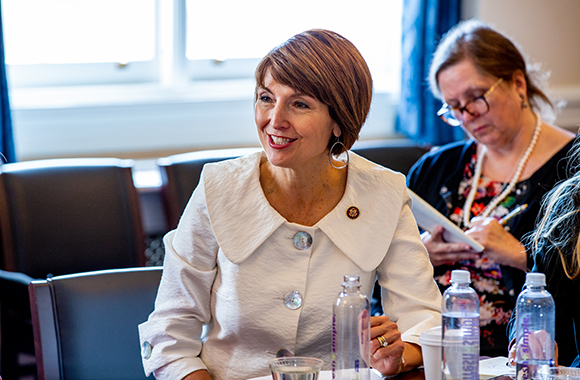By Sally Greenberg, NCL CEO
One of the dates seared into my memory from a young age is February 12 —President Abraham Lincoln’s birthday. We’ve had some truly heroic presidents, but it’s hard to compare any to the towering figure of Abraham Lincoln.
One of my favorite Lincoln quotes is this: “I am a firm believer in the people. If given the truth, they can be depended on to meet any national crisis. The great point is to bring them the real facts.”
As we enter the age of the second Donald Trump presidency, I’m reminded of Lincoln’s wisdom, wit, and kindness—qualities sorely lacking in the current occupant of the Oval Office. And unlike Lincoln, the truth too often eludes Mr. Trump.
This brings me to what the Trump administration is currently doing to try to erase diversity in America. They are waging war on DEIA (Diversity, Equity, Inclusion, and Accessibility), forcing federal agencies to wipe any reference of DEIA from their websites. In the process, they insult and demean millions of Americans and undermine the remarkable diversity that defines our beautiful democracy.
During his famous Gettysburg Address, Lincoln called upon Americans to “bind up the nation’s wounds.” The Trump administration could have heeded that advice and worked to represent all people after the very polarizing election Instead, their attacks on diversity deepen our divides.
Misconceptions about DEIA abound. DEIA initiatives—like implementing accessibility measures for people with disabilities, addressing gender pay inequity, and diversifying recruitment outreach—exist to correct discriminatory organizational practices. As Erica Foldy, a professor at NYU’s Wagner Graduate School of Public Service, explains, DEIA efforts don’t discriminate; they put employers “on the path of creating more merit-based companies, more merit-based firms,” aiming to ensure that qualified people of all backgrounds have an “equal chance of being hired; you’re going to be paid the same as employees at comparable levels.”
Research from management consulting firm McKinsey & Company found that companies with more diversity financially and socially outperform those that are less diverse.
“The most successful companies understand that DEI isn’t just a ‘”nice-to-have,'” said Christie Smith, the former vice president for inclusion and diversity at Apple. “It’s a driver of innovation, talent attraction, and competitive advantage.”
I was among the many in my generation who marched on Washington for civil rights, women’s rights, reproductive rights, and LGBTQ+ rights. We wrote letters, met with members of Congress, and donated to causes that helped make America great—by making it more inclusive.
The fight didn’t start here. Long before I became head of this organization, the women who founded NCL were championing the rights of children, women, minorities, and immigrants. Florence Kelley, NCL’s first general secretary, was a founding member and signed the original charter forming the NAACP in 1909. She refused to stay in hotels that barred Black guests and was an outspoken advocate for federal anti-lynching laws—a law that wasn’t passed until 2022! Her protégé, Frances Perkins, went on to serve as Secretary of Labor under FDR and, in one of her first acts, desegregated the cafeteria at the Department of Labor.
So championing DEIA – even if they didn’t call it that – has always been in NCL’s DNA. And so many Americans before us waged brave and bruising battles to secure these rights. Rosa Parks refused to give up her seat to a white person on a segregated bus, and her protest sparked the Montgomery bus boycott, paving the way for the 1964 Civil Rights Act, signed by President Lyndon Johnson, which prohibited discrimination on the basis of race, religion, and national origin.
Japanese Americans, many of them U.S. citizens who were born in the U.S., were unjustly imprisoned after Japan attacked Pearl Harbor in 1941. They finally received reparations 47 years later through an act of Congress.
Jewish Americans formed the Anti-Defamation League in 1913 after Leo Frank, a Jew, was falsely accused of murder and lynched by a mob in Georgia.
Throughout the 20th century, gay and lesbian Americans were routinely harassed, arrested, fired from jobs, and discharged from the service until they’d had enough and fought back against yet another police raid. The Stonewall Riot in 1969 at a gay bar in New York City changed history – and many marches later and the formation of gay rights groups like the Human Rights Campaign secured myriad reforms and protections for the LGBTQ+ community.
President George H.W. Bush signed the Americans with Disabilities Act (ADA) in 1990, ensuring basic accessibility measures we take for granted today. So, when you see curb cuts and wheelchair-accessible restrooms, we can thank President Bush and the movement behind the ADA.
I began my career with the Anti-Defamation League in the 1980s, lobbying for hate crimes legislation when it was a novel concept. At first it was a hard sell, but today, every state has hate crime laws. If you paint a swastika on a synagogue or burn a cross on a lawn, that’s not just vandalism—it’s a hate crime because we recognize that targeted violence against certain groups (all DEIA Americans) is an attack on our democracy. And. I’m pretty sure we aren’t repealing those hate crime laws!
I am saddened that so many Americans have fought and gained hard-won rights and protections that are now under attack. Memo to Trump and his allies: America’s embrace of difference and diversity makes us a beacon to the rest of the world.
Finally, Lincoln once said, “The philosophy of the schoolroom in one generation will be the philosophy of government in the next.” So, though the Trump administration may try to erase our land of difference and diversity, good luck with that.
The far-right thinks they have a right to control what we say, think, read, and do, but Americans don’t take kindly to being told what to do.
Most of us have grown up in a country that is far more diverse and embracing of differences than the generations before us. Diversity, alas, is our superpower and our future. You can try to erase it or ban it, but the genie is out of the bottle—and no executive order or website purge will put it back in. One way or the other, it is here to stay.
And hallelujah for that.






 By Eden Iscil, Senior Public Policy Manager
By Eden Iscil, Senior Public Policy Manager By Nancy Glick, Director of Food and Nutrition Policy
By Nancy Glick, Director of Food and Nutrition Policy
 A version of this guest post was originally published by the
A version of this guest post was originally published by the 
 By Sam Sears, Health Policy Associate, National Consumers League
By Sam Sears, Health Policy Associate, National Consumers League














